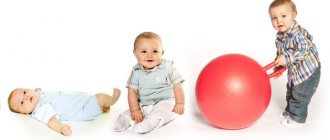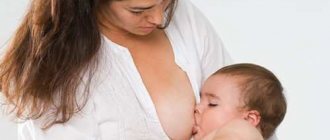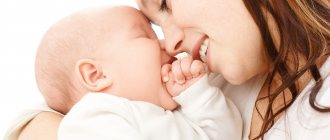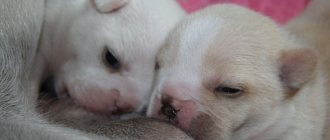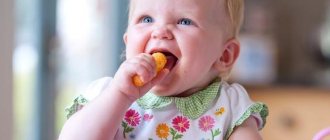Norms of child development by month to year
A small child born into a home is a tiny miracle and a great joy for loving parents. The first year of a baby’s life is about receiving and assimilating a huge amount of information. Learning and mastering skills that the baby will improve in subsequent years. Formation of character and acquisition of habits that can help or hinder in adult life. Knowing how a child’s development should proceed month by month will help parents create conditions for the harmonious growth of the baby.
Parents are often concerned about the following questions: how to properly raise a baby, what to teach, what skills to develop and in what order. Parents are also worried about how the baby is developing, whether he is falling behind the norm. You need to understand that there are no strict time frames that indicate what and on what day a child should be able to do. Each child is unique and individual. And the baby develops in accordance with its internal calendar.
Attentive and conscientious parents and grandparents can help the baby quickly get used to the world. By giving their love and care to the little person, parents create a favorable psycho-emotional field for the baby. Children raised in a loving family have better health and learn new skills faster. You should contact specialists, pediatricians and psychologists if there is a noticeable significant lag in development from peers.
Calendar, child development by month
The first month is a period of adaptation to new circumstances and surroundings. Developing in the mother's tummy, the baby was protected from external influences. After birth, the baby must learn a new way of breathing, getting food, and get used to new auditory and visual sensations.

The main activity of a baby in the first month is sleep and nutrition. The baby does not distinguish the time of day, he does not care whether it is night or day. The main thing for the baby is good nutrition and comfortable sleeping conditions.
The baby's muscles are very weak, the baby cannot hold his head on his own. When feeding, the mother should hold the baby's head. There is slight swelling of the body. Muscle tone is increased. The arms are clenched into fists, the legs are in a springy state.
Second month. The baby is sleeping less now. The period of continuous wakefulness can be about 20 minutes every hour. Facial features become more pronounced and clear. The puffiness has practically disappeared. The baby begins to show interest in everything that surrounds him.
Vision develops. The baby can already fix his gaze on an object for a short time. He tries to look at the bright toys and his mother’s face. If you slowly hold the toy in front of your eyes, your eyes will begin to follow it.
Hearing develops. Loud, sharp sounds can frighten the baby. He recognizes his mother's voice. He grunts at his mother’s words and tries to make sounds. If the mother actively communicates with the baby, then by the end of the first month, the baby may begin to walk and sing individual sounds.
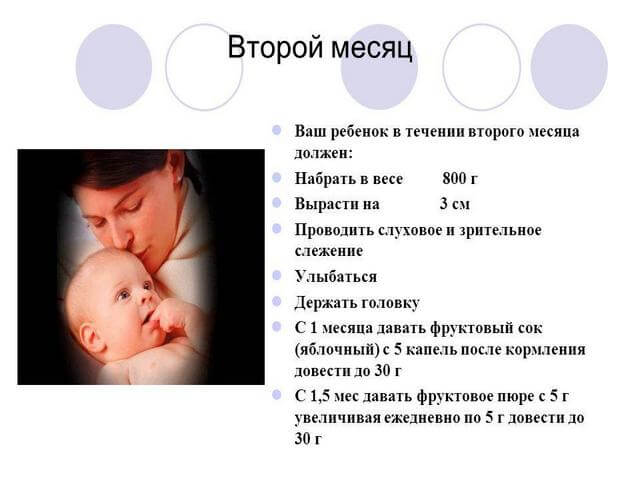
The neck muscles are also weak, but he holds his head longer. It's time to lay the baby on his tummy to strengthen his back muscles. She greets her mother with animated movements of her arms and legs. Understands voice intonation. Starts to smile. The hands are still clenched into fists, but if you give the baby a rattle, he will try to hold it.
Third month. A daily routine begins to form. At night, the baby can sleep 5-6 hours and not wake up. Daytime sleep time is also reduced. The baby is already confidently holding his head. Lying on his tummy, he raises his forearms, while resting his legs.
The hypertonicity is almost gone. Arms and legs are relaxed during sleep. Actively tries to reach for different objects, tenaciously holds the rattle. They look at their hands, stick them in and suck on their fists.
Begins to pronounce syllables instead of individual sounds, and gurgles. Can talk to himself for a long time. Some children are already trying to laugh. He can be capricious if he doesn’t like something.
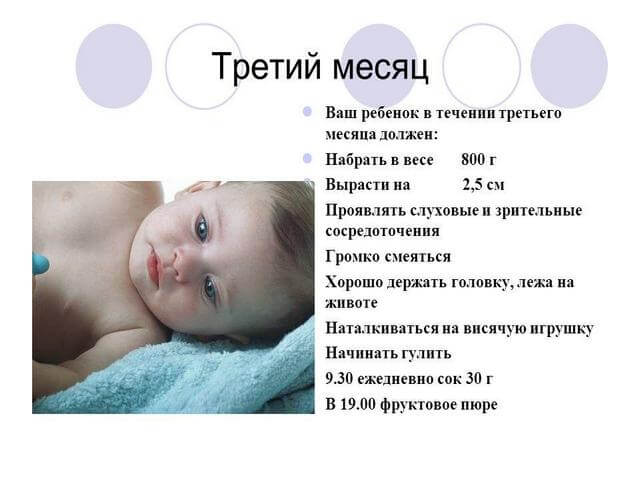
Fourth month. The duration of night sleep increases to 8 hours. The baby confidently holds his head and turns it to the sides. If the baby is held under the arms, he may not be able to stand on his legs for long. Purposefully takes toys and throws them. Already have favorite toys.
Rolls over from back to tummy. Some children begin to move by rolling, so you should not leave children of this age on the sofa or adult bed. Lying on his back, he understands his shoulders and head and tries to sit up.
Recognizes parents and can call by shouting or movement. There is a fear of losing my mother. Therefore, he tries not to let her out of sight. If mom leaves the room, she starts crying loudly. Knows his name. Turns his head or looks at the person who called him.
Fifth month. The baby can sit for a short time while on a chair with support. Raises himself on outstretched arms, lying on his tummy. Trying to crawl. Some children, holding onto a support, try to stand on their feet.

Clearly distinguishes between friends and strangers. At the sight of a stranger, he may become frightened and cry. Able to recognize faces in photographs. Looks at pictures in books. He sings along when he plays “okay” with the baby. Speech is clearer, you can learn the words: mom, dad, baba.
Seeks communication, but can also play on his own for 10-15 minutes. Facial expressions develop. In addition to crying and smiling, the baby can frown and laugh. Many babies are starting to teethe.
The little one is six months old. Can crawl a short distance to the toy. Trying to get out of the stroller or crib. He is already sitting on his own. They begin to understand words such as you can’t, give, eat.
They listen with great attention to what adults tell them. Looks for the object the parent is talking about. Syllables are pronounced confidently. The first consonants appear in speech.
Knows how to lift toys, move them from handle to handle or from one box to another. I really like studying toys and breaking them. Understands the connection between actions: he threw a toy, it fell.
Seventh month. Almost all children have already mastered the ability to crawl at this age. It is no longer possible to keep the fidget in one place. It is necessary to prepare a place for the baby to crawl. Remove breakable and heavy objects. Place a rug on the floor.
Holds your back straight when sitting. Stands independently at a support. Loves games where they play with their fingers “Magpie - white-sided”. It actively crawls not only in the room, but throughout the entire apartment. Loves to walk when the baby is held by the hands.
Knows what arms, legs, nose, mouth, and other parts of the body are. He can show them with his finger. Loves to swim while sitting in the bathtub, playing in the water with toys.
Eighth month. The baby's development continues more and more intensively. Now the baby takes things and toys not with his whole palm, but with his fingers. He can take a long time to disassemble and assemble pyramids and build towers. The machine can open and show the door.
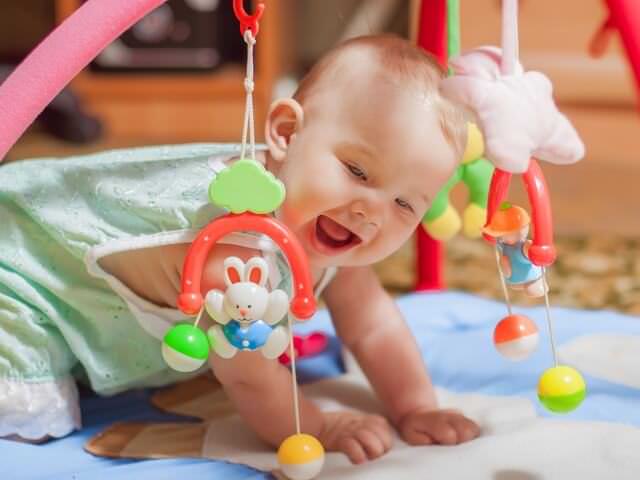
Although he crawls a lot, he tries to get up and walk on his legs more and more often. If you hold him by the handles, he will examine the entire apartment. I like listening to music and dancing. He claps his hands animatedly and tries to jump.
Knows how to say hello and goodbye by waving his palm. The baby understands what adults are asking. He can fulfill a small request: show a toy, treat him with candy.
The number of sounds that the baby makes increases. Usually at this age the words mom and dad are consciously pronounced for the first time.
By 8 months, almost all babies can boast of 4 teeth. 2 on top and 2 on bottom. They begin to bite off solid food in small pieces. Children begin to refuse foods they don't like. They push their hands away, clench their teeth. If you like an item, they may try to take it away by force.
Ninth month. The skills and abilities acquired earlier are developed and improved. Now the child can get up from a sitting position, or sit down from a lying position. The child stands firmly against the support and moves around holding onto the sofa or the edge of the bed. When crawling, it can change direction and crawl back.
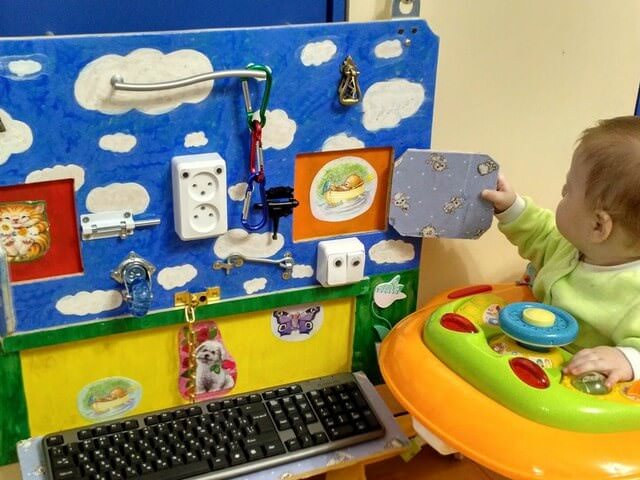
New skills are being developed:
- Stick your fingers into the holes. All sockets in the apartment should be covered with special covers.
- Tear paper.
- Knead the dough and plasticine. Modeling is especially good for developing fine motor skills.
They know the names of many objects and words. They understand the requests of elders well. The baby remembers where mom put the toys and tries to get them.
They begin to try to manipulate their parents with the help of screaming and tears. Children are very sensitive to the mood of their parents. If mommy makes concessions and fulfills the baby’s whims, then these whims will intensify. It’s worth immediately explaining to the little one quite decisively that you can’t act badly and be capricious. The baby must understand that if mom said no, then tears and hysterics will not achieve anything.
He begins to try to dress himself. Drinks well from a mug when held a little. The baby eats himself with a spoon.
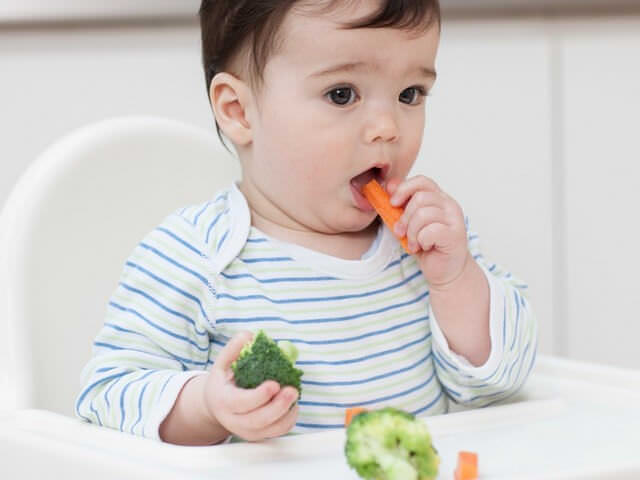
Tenth month. Children learn to step or crawl over obstacles. They can go up or down 2-3 steps. They actively study all the closets in the house, open the doors, take out and throw things away.
They love to help mom in the kitchen or with cleaning. To please their beloved mother, they can paint the walls with a felt-tip pen. You should not scold the baby or forbid him to help adults. It is better to direct the initiative in a constructive direction. Give a box and offer to put toys there. Give a piece of dough in your hands and ask them to roll it out; this will take up the baby’s time for a long time.
Already trying to play with other children. In such a situation, the help of parents will be invaluable. Show how to sculpt Easter cakes, build a mound, and collect sand in a bucket. At 10 months, motor skills are already quite well developed, which allows the baby to hold several irregularly shaped things in his hand at once.
Eleventh month. The most long-awaited achievement is that the child can speak. Children have approximately 10-15 words in their vocabulary. When a child does not have enough words to say something to adults, the little one will try to explain himself with gestures and facial expressions. The little man portrays animals well: mu - cow, meow - kitty. Bibika is a machine.
He already almost completely understands the meaning of the words addressed to him. Likes to listen carefully to adults' conversations. Behaves independently: puts on socks and shoes, brushes teeth, combs hair.
He loves it very much when he is praised, but gets upset when they start scolding him. Knows how to be sad, bored, angry, happy. I learned to nod in agreement. When he refuses, he waves his head from side to side.
Twelfth month. Children's first serious anniversary. Most children begin to walk at 12 months. But if your baby hasn't walked yet and still loves to crawl, don't be upset. Pediatricians consider this to be the norm; a child can crawl for up to one and a half years.
Now the baby has a lot of developing games in his kitty. The baby can:
- collect pyramids, build towers;
- throw, catch, roll balls;
- rocks dolls to sleep, feeds them Easter cakes; plays with cars.
Food preferences emerge. There are favorite things and toys. Knows how to talk on the phone, knows whose phone is ringing.
He understands everything that is said to him. If he disagrees, he can throw hysterics, scream, and cry. The rules of behavior should be explained to the baby.
Weight, height and physical activity
It is no coincidence that in the first year of a child’s life, it is customary to examine him monthly by a pediatrician, and sometimes with the involvement of specialized specialists. For example, at 2 months the baby is also examined by a neurologist, an orthopedic surgeon and an ophthalmologist. This is due to the intensive rate of growth and development of the infant during this period. Medical examinations include measuring weight, height, chest and head circumferences, and testing vision, hearing and motor skills.
The weight of a child at 2 months increases by about ¼ of the weight that was a month ago. That is, the baby becomes 750-1000 grams heavier. If we distribute these numbers over days and weeks, we get approximately 250 g increase weekly and 30-35 g daily! Growth is also not lagging behind: the child stretches by 4 cm (that is, a centimeter per week)! The circumference of the breast and head increases evenly: by 1.5-2 cm.
Such rapid growth rates indicate the intensive development of all internal systems and organs in the baby’s body. And his life rhythms entirely contribute to this. The baby spends a lot of time sleeping (about 20 hours), and during waking hours he actively feeds (1/5 of his body weight per day). After each feeding, you shouldn’t rush to the scale and check how much he sucked. After all, every time a baby is attached to the breast, he can satisfy different needs (for food, for drinking, for tactile sensations).
Useful: Daily routine of a 2 month old baby (hourly schedule)
If you previously laid your newborn on his tummy, then a 2-month-old baby will already be able to hold his head and chest in an elevated state for several seconds. Such exercises should be done more often to strengthen the muscular framework of the cervical-collar area. Stroking your palms, which are most often clenched into fists, also brings benefits. The grasping reflex is developed quite strongly; if you put a rattle in the baby’s hand, he will be able to hold it for some time. At 2 months, the congenital hypertonicity of the infant’s limbs gradually disappears. This is expressed in the gradual relaxation of the body, arms, legs, hands.
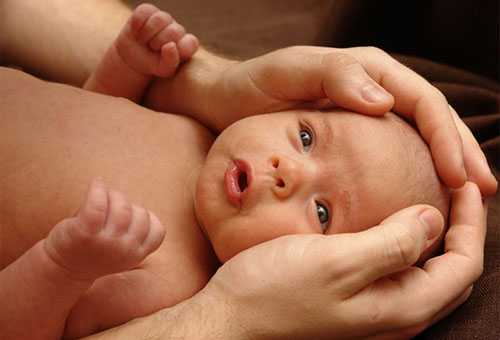
Child development indicators
Weight - immediately after birth, the baby loses a little weight. But already in the first month he gains 700-800g. A normal increase is considered if by 6 months the baby’s weight doubles. At one year, the baby should weigh about 3 times more than at birth.
Growth - during the first 5-6 months, the baby's height increases monthly by 2 - 3 cm; after six months, growth slows down and amounts to 1 - 2 cm per month.
Physical activity. The child’s ability to hold his head, roll over from tummy to back, sit, crawl, walk.
Speech development. The initial groaning of the baby by 2 months is replaced by humming. Later the baby switches to cooing and babbling. By the age of one year, a child’s vocabulary should consist of approximately 10-15 words.
The presented calendar shows the average abilities of children over time. Physical growth and weight in premature babies will be slightly behind the average norm. Usually, after a year, children level out in their performance.
The first year of life is very difficult for both the baby and his parents. The life of a little man, the development of his skills and abilities in the hands of loving parents. You must be able to accept and love your baby as he is, guide him, and help him develop.
Baby's vision, hearing, speech
At 2 months, the child is already able to recognize and respond appropriately to familiar sounds: parents’ speech, a rattle, a musical nanny. The baby turns his head, trying to understand which direction the sound is coming from. The baby's eye muscles develop, and his gaze becomes focused. He begins to distinguish shapes, colors, and is actively interested in moving bright objects. But what he looks at most carefully is the human face. The faces of relatives become so close, desirable, and recognizable.
The range of vision of a baby at 2 months is 40-50 cm. Toys suspended at this distance fall into his visual field, and he will already try to grab them with his hand. But eye-hand coordination will finally be formed a little later, during the 3rd month of life. When the child is at an appointment with a neurologist, he will use his auditory and visual abilities by moving a bright toy (or a special instrument) from side to side in the line of sight, while lightly tapping it.
In the second month of a child's life, he begins to consciously try his vocal cords. When the baby is full, but not sleeping, he can make various sounds: from “a-o” to “gut” and rumbling guttural rumbles. Of course, this is still far from speech, but it is already an additional means of communication. The duration of the baby’s “humming” and “babbling” depends on his mood, well-being and the reaction of adults. If you support his “undertakings”, talking to him in “his language”, teaching him new sounds, then the child will happily support the “dialogue”.
Useful: All about teething in children
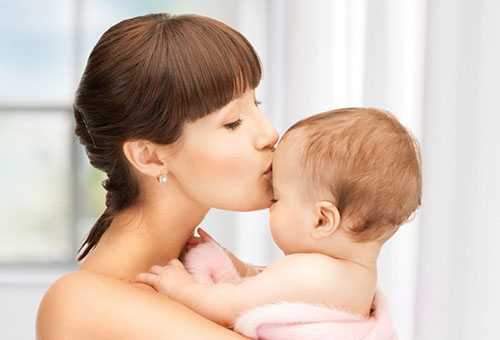
Features of the first days of life
After the birth of a baby, many parents experience severe anxiety and concern for the child. It is important for them that everything is fine with him and that there are no deviations.
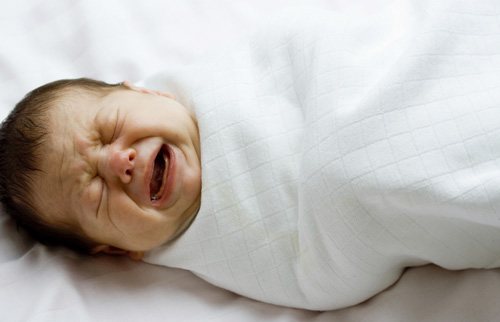
In the first days after birth, the baby’s body undergoes serious physiological changes:
- Postpartum swelling goes away.
- The bone tissue of the skull becomes stronger and stronger.
- The outlines of the face become clearer and more expressive.
- Serious changes in vision are observed. There is an improvement in eye coordination and gaze focusing. The functioning of the senses improves.
- The gastrointestinal tract begins to get used to the new diet and is filled with beneficial microflora.
- The baby's blood circulation and hematopoiesis begin to change. In the first month of life, red blood cells carrying fetal hemoglobin are destroyed, and new red blood cells appear in their place.
Note! In the first month of life, the child experiences frequent urination - up to 6 times a day.
The urine released has a clear structure and is odorless. A child aged 1 month has bowel movements up to 12 times a day, usually immediately after feeding.
In this case, the stool has a yellow color and a mushy structure.
Development scheme by week
After birth, you should carefully monitor the condition and development of the baby during the first 4 weeks.
At this time, various defects, abnormalities, and diseases can be detected that can be quickly eliminated.
Many babies develop jaundice after birth, which disappears over time.
Below is a calendar of the development of a newborn by week, which reflects general information about the physical and emotional sphere of the baby at this time, as well as his skills and achievements.
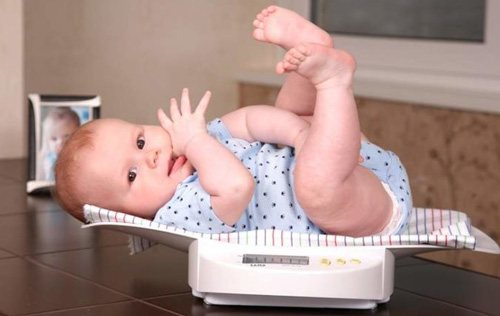
Consider:
| A week | Peculiarities |
| First | At this time, he begins to hold his head for a few seconds, he can focus his gaze at a distance of 5 to 15 cm. He can involuntarily close and open his fingers |
| Second | At this time, his hearing and vision develop. He looks at the adults with interest. Reacts to mother's words, sounds of rattles, fixes his gaze on bright toys |
| Third | The baby can calmly hold his head for 5 seconds, raises it after rest, and recognizes mom and dad. He examines with interest the faces of surrounding people and objects at a distance of 50 cm |
| Fourth | The baby's head shape is fully formed. At this time, he begins to actively move his arms and legs, he recognizes his mother by her voice and smell. Calmly focuses his gaze on people and objects at a distance of up to 1 meter. Raises the head while lying on the stomach for 5 seconds |
How do the senses develop at this age?
Vision
The baby watches moving objects with interest. So, on a walk you can see how he follows falling leaves or cars with his eyes. He can already clearly distinguish the faces of mom and dad and greets them with a joyful smile. Interesting bright toys can captivate him for as long as 7 minutes.
Hearing
When loud sounds occur, the baby begins to blink and turn its head in search of the source of the sound. And when his mother, bending over him, begins to sing songs and hums in response with pleasure. Due to the fact that at this age the nervous system begins to develop, the baby is extremely susceptible to noise around him. Therefore, it is worth protecting it as much as possible from loud and annoying sounds. Psychologists recommend setting aside several hours a day to listen to classical music with your child, supposedly this helps his more harmonious development.
We recommend that you read: What a 4 month old baby should be able to do
Tactile sensations
Massage is extremely important at this age not only to improve physical condition, but also to develop tactile sensations. The touch of mother's hands, a cloth, water - all this evokes new emotions and impressions in the baby.
It is from two months that it is recommended to purchase a special developmental mat on which you can place the baby to replenish the arsenal of sensations and the still emerging motor skills of the fingers.
Development table by month
To assess the emotional and physical state of a boy or girl, doctors have developed a special table of child development by month.
It reflects important stages by which you can understand how the baby grows and develops.
And most importantly, it helps to understand whether everything is normal for him, whether he has delays in growth and other indicators.
Below there is a table that shows the general indicators of the baby’s development from 1 month to a year. They will help parents understand how a child should grow and develop.
If this period does not go well for him, then this may be the first prerequisite for visiting a pediatrician, but still, all children develop differently.
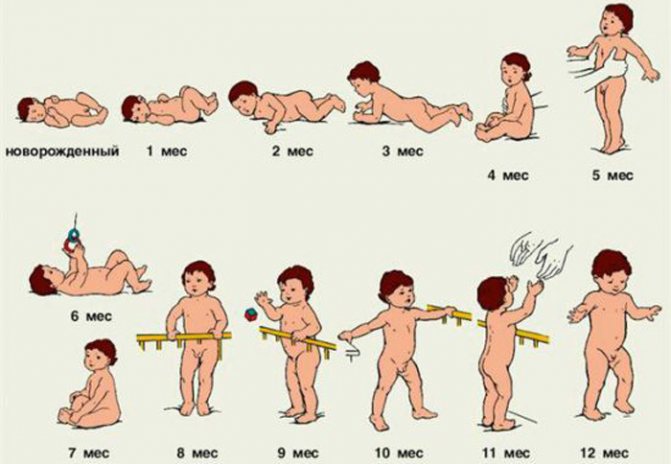
Consider:
| Age | Skills |
| At the time of birth | At this time, many parents note the active revival of the baby. Moves legs and arms while awake. He shudders and begins to blink at sharp sounds. Responds to stimuli by crying |
| 1 month | Tries to raise his head in a position on his stomach and hold it for up to 5 seconds. Watches moving bright objects and the adult's face. Reacts to sharp sounds. He answers with a smile. Starts to buzz |
| 2 months | In the second month he holds his head for a long time. Turns towards the sound of an adult speaking. Grasps objects reflexively. Actively interested in the world around him. Cooing |
| 3 months | Holds his head well in a vertical position. Looks at objects for a long time. Makes different sounds. When lying on the stomach, it is raised on the forearms. Turns on its side from behind. Sucking fingers or fist |
| 4 months | Confidently raises his head while lying on his tummy. Holds mother's breast or bottle with her hands during feeding. Laughs and smiles when playing. It goes on for a long time. Lying on your back, raises your head and shoulders |
| 5 months | Recognizes mother and other close people. Grasps and holds objects with both hands. Takes an object from an adult's hands. Sits with support. It hums for a long time. Responds to nursery rhymes and songs heard. Looks at pictures |
| 6 months | Sits without support. He reaches out his hands to an object that interests him. Picks up a toy that has fallen out of his hands. Tests objects to their teeth. Starts to crawl. Begins to pronounce syllables |
| 7 months | Crawls and sits well. Stands with support from both hands. Plays with toys for a long time, studying their properties. Drinks from a mug with the help of an adult. Trying to sit up |
| 8 months | Looking for a toy that has fallen. Transfers an object from one handle to another. Stands up, holding onto support. Crawls quickly. Shows familiar objects, answering the question “where?” Holds solid food (crackers, cookies) independently. Afraid of leaving mom |
| 9 months | Tries to stand and take the first steps. Imitates other children. Reaches towards an object of interest and tries to get it |
| 10 months | Begins to pick up small objects with fingers. He sticks his fingers into holes and opens drawers. Plays hide and seek. Walks with the support of two adult hands. Can go up and down stairs (3-4 steps). Tries to feed himself with a spoon |
| 11 months | Stands alone. Walks with support from one hand. Lifts objects without squatting (bending). Able to sit down without support. Stacks cubes. Begins to pronounce “light” words. Development of fine motor skills, holding toys and exploring them |
| 12 months | Trying to walk on his own. Stands up from a squatting position. Drinks from a cup independently. Understands the words “cannot” and “can”. Recognizes animals and shows them in pictures and on the street. Says 10-15 words |
Physical development of a baby at 2 months
As for sleep and wake periods, the baby will still sleep most of the time. The sleep period will be approximately 18 hours a day. Extended periods of wakefulness are accompanied by prolonged examination of surrounding objects, which the baby studies with concentration and interest. This is how he develops eye coordination, concentrating it on studying the world around him.
Good to know : how long should a baby sleep?
Actively studying the world around him and objects, in particular children's toys and rattles, he begins to form his first idea of the color scheme of the world around him. In fact, at this point he cannot yet distinguish colors, but bright objects help him develop color vision.
Turning the head to the side will be added to the physical skills of a child in the second month of life. He will also begin to try to lift it and hold it in this position for about 20 seconds. The reduced tone of the flexor muscles of the child’s legs and arms will be replaced by an increase in tone in the extensor muscles. Thanks to this, he will be able to perform new movements with his hands:
- raise the handles;
- stretch with the help of the handles;
- spread your arms to the sides.
Reading...
Fitball for infants: basic exercises and ball selection
More > Different baby skills at 6 months
Parents will be able to notice how the baby easily finds his hands, looks at them for a long time, has fun, bending and unbending his fingers, clenching his fists. Finger movements are especially important, since the development of his nervous activity directly depends on them. If you run a soft or fluffy object over your baby's arms or legs, he will freeze from the affectionate touch. He begins to consciously sense all objects that come to him and identify them by the degree of softness, roughness and other physical parameters.
The first conscious movement mastered during this period will be raising the head and partly the chest while lying on the tummy. As for lifting and holding the head, the baby not only does this quite confidently in a position lying on his tummy, but also makes attempts from a vertical position. However, parents should not relax and still need to control the movements of their little one. It is better to hold the head when it is necessary to lift the baby from the crib or when he is in his arms.
For many children, it is during this period that the first conscious turning from a lying position to a side occurs - onto the back. The first attempts may be accompanied by falls or the child may become frightened, so he must be supervised during the waking period.
At 2 months of age, two main reflexes still predominate:
- Grasping, when the child clenches his fists with force. It is recommended to periodically help him unclench them and even give a light massage to the palmar surface of the arms and fingers.
- Sucking, with the help of which the baby eats, sucks on a pacifier and other objects that fall into his mouth. At the same time, he is already beginning to understand the difference between sucking movements that satisfy hunger and will easily understand that he was given a pacifier when he wants to eat. At 2 months of age, very often babies tend to suck their fingers - this action is also conscious .
Reading...
At what months do children begin to walk with and without assistance?
More > What to do to stop your child from sucking his fingers
Rules of care
Important! Dr. Komarovsky says that there is no need to worry too much if the child lacks certain reflexes and skills during certain months. All children are different, some develop specific skills earlier, others later.
Every parent must provide the baby with care and concern.
For this reason, it is worth remembering several important recommendations:
- To strengthen the hip joints, doctors prescribe a set of exercises and techniques that should be carried out by specialists.
- From birth to one year, the baby should experience full mental and psychomotor development. To do this, the child needs to be shown colorful toys and rattles from the second birthday. And when he learns to hold them, you should give them in his hands so that he can finger them and look at them.
- Infant nutrition plays an important role in the development of a newborn child. It should consist exclusively of mother's milk, which contains all the required vitamins. From about 6 months, complementary foods can be introduced.
- The development of speech and hearing is important for a child, so you need to constantly talk to him, read books to him, and show him pictures.
The causes of defects and abnormalities should be determined by a doctor only after a complete examination of the baby.
But it is still worth considering that children, just like adults, have individual developmental characteristics.
Don't worry if your child has slight delays. Over time, all this will pass, the main thing is to provide him with complete care and attention.



